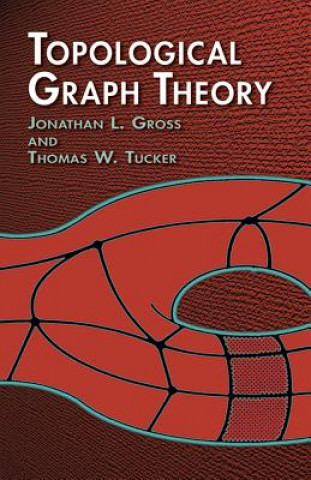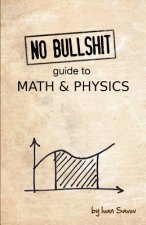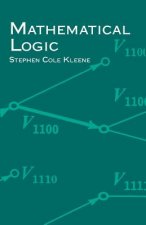
Code: 02565597
Topological Graph Theory
by Gross & Tucker
1. Introduction 1.1 Representation of Graphs 1.1.1 Drawings 1.1.2 Incidence Matrix 1.1.3 Euler's theorem on valence sum 1.1.4 Adjacency Matrix 1.1.5 Directions 1.1.6 Graphs, maps, isomorphisms 1.1.7 Automorphisms 1 ... more
- Language:
 English
English - Binding: Paperback
- Number of pages: 361
Publisher: Dover Publications Inc., 2003
- More about this

19.84 €
RRP: 20.91 €
You save 1.07 €
Availability:
50/50 We think title might be available. Upon your order we will do our best to get it within 6 weeks.
We think title might be available. Upon your order we will do our best to get it within 6 weeks.We search the world
You might also like
-

LEGO Life Hacks
12.58 € -13 % -

Read with Oxford: Stages 2-3: Biff, Chip and Kipper: My Phonics Kit
14.42 € -23 % -

Harry Potter and the Chamber of Secrets - Ravenclaw Edition
18.72 € -9 % -

Mid-Century Modern Graphic Design
30.89 € -13 % -

Networks
81.44 € -

Midnight Hour
7.97 € -22 % -

Lonely Planet Chicago
22.81 € -

Brand Portfolio Strategy
25.26 € -18 % -

Niggalations: The Lost book of Ghetto Philosophers: Inspirational quotes
16.16 € -

Terra Incognita
29.87 € -20 % -

STM32F103 Arm Microcontroller and Embedded Systems
29.56 € -

Bing: My Toilet Train Sticker Book
3.98 € -34 % -

All about Bluey
5.72 € -31 % -

Rota Mundi Tarot: The Rosicrucian Arcanum
31.20 € -13 % -

Why We're Polarized
11.35 € -21 % -

Classic Works from Women Writers
24.96 € -5 % -

Mystery Colors: Christmas: Color by Number & Discover the Magic
12.37 € -

Bees, Birds & Butterflies Sticker Anthology
24.24 € -

30 and 1 Indian Mantras for Tongue Drum and Handpan
16.16 € -

Sonic The Hedgehog: The IDW Collection, Vol. 2
48.39 € -20 % -

Subtle Art of Not Giving a F*ck Journal
15.24 € -21 % -

Perfect Day to Boss Up
14.42 € -23 % -

Radiant Black, Volume 3: A Massive-Verse Book
14.83 € -19 % -

Bungo Stray Dogs: Another Story, Vol. 2
11.96 € -16 % -

Imogen, Obviously
18.41 € -14 % -

Avatar The Way of Water The Visual Dictionary
29.97 € -15 % -

Girl, Goddess, Queen
16.57 € -23 % -

Marie Laurencin – Sapphic Paris
49 € -3 % -

Saving 6
13.19 € -6 % -

Star Wars: Episode III: Revenge of the Sith
12.27 € -23 % -

Pocket Atlas of Remote Islands
21.17 € -23 % -

Burning Bridge
9.20 € -19 % -

The Concise Art of Seduction
10.22 € -24 % -

Healing Scripts
48.39 € -

Dragon Ball Z, Vol. 14
8.89 € -22 % -

The Art of Spirited Away
31.30 € -13 % -

How to Read a Book
14.11 € -11 % -

Languages of the World
93.31 € -

Refactoring
53.92 € -

Edward's Crochet Imaginarium
21.99 € -23 % -

The Oxygen Advantage
16.57 € -23 % -

Sketching Product Design Presentation
38.36 € -17 % -

Galgo Espanol
32.32 € -

Guess How Much I Love You
7.25 € -24 % -

Test Your English Vocabulary in Use Upper-intermediate Book with Answers
23.73 € -

Transport Nodal System
128.41 € -

Orlando
8.38 € -24 % -

Art of Tatting Jewelry, The
17.18 € -18 % -

TNM Classification of Malignant Tumours 8e
61.69 € -

George Elton Mayo
844.79 € -

Romantic Poets
13.60 € -17 % -

Testuj Swoj Polski: Gramatyka 1: Test Your Polish: Grammar 1
9.81 € -5 % -

Tell-tale Brain
15.54 € -19 % -

MAYA BLUE
29.97 € -3 % -

Vauxhall/Opel Vectra Petrol & Diesel Service And R
36.83 € -9 % -

Spektrum Deutsch B2: Teilband 1
17.90 € -

Mit Erfolg zum Goethe-Zertifikat C1 - Ubungsbuch
24.14 € -7 % -

Krimi-Advent mit Sherlock Holmes, Zettelkalender
16.05 € -2 % -

Ciekawski George w wielkim mieście
3.47 € -4 % -

Macarons
9.92 € -31 % -

Pourquoi les riches votent à gauche
32.12 € -

Zwierzaki. Malowanka z pisakiem wodnym
6.64 € -

Animal Man Omnibus
54.63 €
Give this book as a present today
- Order book and choose Gift Order.
- We will send you book gift voucher at once. You can give it out to anyone.
- Book will be send to donee, nothing more to care about.
Availability alert
Enter your e-mail address and once book will be available,
we will send you a message. It's that simple.
More about Topological Graph Theory
You get 49 loyalty points
 Book synopsis
Book synopsis
1. Introduction 1.1 Representation of Graphs 1.1.1 Drawings 1.1.2 Incidence Matrix 1.1.3 Euler's theorem on valence sum 1.1.4 Adjacency Matrix 1.1.5 Directions 1.1.6 Graphs, maps, isomorphisms 1.1.7 Automorphisms 1.1.8 Exercises 1.2 Some important classes of graphs 1.2.1 Walks, paths, and cycles; connectedness 1.2.2 Trees 1.2.3 Complete graphs 1.2.4 Cayley graphs 1.2.5 Bipartite graphs 1.2.6 Bouquets of Circles 1.2.7 Exercises 1.3 New graphs from old 1.3.1 Subgraphs 1.3.2 Topological representations, subdivisions, graph homeomorphisms 1.3.3 Cartesian products 1.3.4 Edge-complements 1.3.5 Suspensions 1.3.6 Amalgamations 1.3.7 Regular quotients 1.3.8 Regular coverings 1.3.9 Exercises 1.4 Surfaces and imbeddings 1.4.1 Orientable surfaces 1.4.2 Nonorientable surfaces 1.4.3 Imbeddings 1.4.4 Euler's equation for the sphere 1.4.5 Kuratowski's graphs 1.4.6 Genus of surfaces and graphs 1.4.7 The torus 1.4.8 Duality 1.4.9 Exercises 1.5 More graph-theoretic background 1.5.1 Traversability 1.5.2 Factors 1.5.3 Distance, neighborhoods 1.5.4 Graphs colorings and map colorings 1.5.5 Edge operations 1.5.6 Algorithms 1.5.7 Connectivity 1.5.8 Exercises 1.6 Planarity 1.6.1 A nearly complete sketch of the proof 1.6.2 Connectivity and region boundaries 1.6.3 Edge contraction and connectivity 1.6.4 Planarity theorems for 3-connected graphs 1.6.5 Graphs that are not 3-connected 1.6.6 Algorithms 1.6.7 Kuratowski graphs for higher genus 1.6.8 Other planarity criteria 1.6.9 Exercises 2. Voltage Graphs and Covering Spaces 2.1 Ordinary voltages 2.1.1 Drawings of voltage graphs 2.1.2 Fibers and the natural projection 2.1.3 The net voltage on a walk 2.1.4 Unique walk lifting 2.1.5 Preimages of cycles 2.1.6 Exercises 2.2 Which graphs are derivable with ordinary voltages? 2.2.1 The natural action of the voltage group 2.2.2 Fixed-point free automorphisms 2.2.3 Cayley graphs revisited 2.2.4 Automorphism groups of graphs 2.2.5 Exercises 2.3 Irregular covering graphs 2.3.1 Schreier graphs 2.3.2 Relative voltages 2.3.3 Combinatorial coverings 2.3.4 Most regular graphs are Schreier graphs 2.3.5 Exercises 2.4 Permutation voltage graphs 2.4.1 Constructing covering spaces with permutations 2.4.2 Preimages of walks and cycles 2.4.3 Which graphs are derivable by permutation voltages? 2.4.4 Identifying relative voltages with permutation voltages 2.4.5 Exercises 2.5 Subgroups of the voltage group 2.5.1 The fundamental semigroup of closed walks 2.5.2 Counting components of ordinary derived graphs 2.5.3 The fundamental group of a graph 2.5.4 Contracting derived graphs onto Cayley graphs 2.5.5 Exercises 3. Surfaces and Graph Imbeddings 3.1 Surfaces and simplicial complexes 3.1.1 Geometric simplicial complexes 3.1.2 Abstract simplicial complexes 3.1.3 Triangulations 3.1.4 Cellular imbeddings 3.1.5 Representing surfaces by polygons 3.1.6 Pseudosurfaces and block designs 3.1.7 Orientations 3.1.8 Stars, links, and local properties 3.1.9 Exercises 3.2 Band Decompositions and graph imbeddings 3.2.1 Band decomposition for surfaces 3.2.2 Orientability 3.2.3 Rotation systems 3.2.4 Pure rotation systems and orientable surfaces 3.2.5 Drawings of rotation systems 3.2.6 Tracing faces 3.2.7 Duality 3.2.8 Which 2-complexes are planar? 3.2.9 Exercises 3.3 The classification of surfaces 3.3.1 Euler characteristic relative to an imbedded graph 3.3.2 Invariance of Euler characteristic 3.3.3 Edge-deletion surgery and edge sliding 3.3.4 Completeness of the set of orientable models 3.3.5 Completeness of the set of nonorientable models 3.3.6 Exercises 3.4 The imbedding distribution of a graph 3.4.1 The absence of gaps in the genus range 3.4.2 The absence of gaps in the crosscap range 3.4.3 A genus-related upper bound on the crosscap number 3.4.4 The genus and crosscap number of the complete graph K subscript 7 3.4.5 Some graphs of crosscap number 1 but arbitrarily large genus 3.4.6 Maximum genus 3.4.7 Distribution of genus and face sizes 3.4.8 Exercises 3.5 Algorithms and formulas for minimum imbeddings 3.5.1 Rotation-system algorithms 3.5.2 Genus of an amalgamation 3.5.3 Crosscap number of an amalgamation 3.5.4 The White-Pisanski imbedding of a cartesian product 3.5.5 Genus and crosscap number of cartesian products 3.5.6 Exercises 4. Imbedded voltage graphs and current graphs 4.1 The derived imbedding 4.1.1 Lifting rotation systems 4.1.2 Lifting faces 4.1.3 The Kirchhoff Voltage Law 4.1.4 Imbedded permutation voltage graphs 4.1.5 Orientability 4.1.6 An orientability test for derived surfaces 4.1.7 Exercises 4.2 Branched coverings of surfaces 4.2.1 Riemann surfaces 4.2.2 Extension of the natural covering projection 4.2.3 Which branch coverings come from voltage graphs? 4.2.4 The Riemann-Hurwitz equation 4.2.5 Alexander's theorem 4.2.6 Exercises 4.3 Regular branched coverings and group actions 4.3.1 Groups acting on surfaces 4.3.2 Graph automorphisms and rotation systems 4.3.3 Regular branched coverings and ordinary imbedded voltage graphs 4.3.4 Which regular branched coverings come from voltage graphs? 4.3.5 Applications to group actions on the surface S subscript 2 4.3.6 Exercises 4.4 Current graphs 4.4.1 Ringel's generating rows for Heffter's schemes 4.4.2 Gustin's combinatorial current graphs 4.4.3 Orientable topological current graphs 4.4.4 Faces of the derived graph 4.4.5 Nonorientable current graphs 4.4.6 Exercises 4.5 Voltage-current duality 4.5.1 Dual directions 4.5.2 The voltage graph dual to a current graph 4.5.3 The dual derived graph 4.5.4 The genus of the complete bipartite graph K (subscript m, n) 4.5.5 Exercises 5. Map colorings 5.1 The Heawood upper bound 5.1.1 Average valence 5.1.2 Chromatically critical graphs 5.1.3 The five-color theorem 5.1.4 The complete-graph imbedding problem 5.1.5 Triangulations of surfaces by complete graphs 5.1.6 Exercises 5.2 Quotients of complete-graph imbeddings and some variations 5.2.1 A base imbedding for orientable case 7 5.2.2 Using a coil to assign voltages 5.2.3 A current-graph perspective on case 7 5.2.4 Orientable case 4: doubling 1-factors 5.2.5 About orientable cases 3 and 0 5.2.6 Exercises 5.3 The regular nonorientable cases 5.3.1 Some additional tactics 5.3.2 Nonorientable current graphs 5.3.3 Nonorientable cases 3 and 7 5.3.4 Nonorientable case 0 5.3.5 Nonorientable case 4 5.3.6 About nonorientable cases 1, 6, 9, and 10 5.3.7 Exercises 5.4 Additional adjacencis for irregular cases 5.4.1 Orientable case 5 5.4.2 Orie 6.1.1 Recovering a Cayley graph from any of its quotients 6.1.2 A lower bound for the genus of most abelian groups 6.1.3 Constructing quadrilateral imbeddings for most abelian groups 6.1.4 Exercises 6.2 The symmetric genus 6.2.1 Rotation systems and symmetry 6.2.2 Reflections 6.2.3 Quotient group actions on quotient surfaces 6.2.4 Alternative Cayley graphs revisited 6.2.5 Group actions and imbeddings 6.2.6 Are genus and symmetric genus the same? 6.2.7 Euclidean space groups and the torus 6.2.8 Triangle groups 6.2.9 Exercises 6.3 Groups of small symmetric genus 6.3.1 The Riemann-Hurwitz equation revisited 6.3.2 Strong symmetric genus 0 6.3.3 Symmetric genus 1 6.3.4 The geometry and algebra of groups of symmetric genus 1 6.3.5 Hurwitz's theorem 6.3.6 Exercises 6.4 Groups of small genus 6.4.1 An example 6.4.2 A face-size inequality 6.4.3 Statement of main theorem 6.4.4 Proof of theorem 6.4.2: valence d = 4 6.4.5 Proof of theorem 6.4.2: valence d = 3 6.4.6 Remarks about Theorem 6.4.2 6.4.7 Exercises References Bibliography Supplementary Bibliography Table of Notations Subject Index
 Book details
Book details
Book category Books in English Mathematics & science Mathematics
19.84 €
- Full title: Topological Graph Theory
- Author: Gross & Tucker
- Language:
 English
English - Binding: Paperback
- Number of pages: 361
- EAN: 9780486417417
- ISBN: 0486417417
- ID: 02565597
- Publisher: Dover Publications Inc.
- Weight: 408 g
- Dimensions: 142 × 216 × 23 mm
- Date of publishing: 28. March 2003
Trending among others
-

Mathematics Applications and Interpretation for the IB Diploma Standard Level
103.03 € -

Lectures in Set Theory
51.97 € -

Mathematics Analysis and Approaches for the IB Diploma Higher Level
86.05 € -

Microsoft Power BI For Dummies
30.28 € -21 % -

No Bullshit Guide to Math and Physics
27.62 € -19 % -

Effective Data Storytelling - How to Drive Change with Data, Narrative and Visuals
34.37 € -20 % -

Princeton Companion to Mathematics
99.55 € -4 % -

Schaum's Outline of Mathematical Handbook of Formulas and Tables, Fifth Edition
16.57 € -23 % -

Mathematics Analysis and Approaches for the IB Diploma Standard Level
103.03 € -

ISE Discrete Mathematics and Its Applications
76.63 € -

Pearson Edexcel AS and A level Mathematics Pure Mathematics Year 1/AS Textbook + e-book
38.36 € -

First Course in Graph Theory
29.15 € -6 % -

Pearson Edexcel A level Mathematics Pure Mathematics Year 2 Textbook + e-book
38.36 € -

Divine Proportion
9.51 € -23 % -

William Lowell Putnam Mathematical Competition 1985-2000
52.48 € -14 % -

Pearson Edexcel A level Mathematics Statistics & Mechanics Year 2 Textbook + e-book
18.51 € -

The Big Book of Analysis
139.46 € -

Einstieg in die beweisorientierte Mathematik
36.01 € -

Schaum's Outline of Essential Computer Mathematics
36.11 € -

Basic Set Theory
25.16 € -3 % -

Methods of Mathematics Applied to Calculus, Probability, and Statistics
47.98 € -4 % -

Mathematical Olympiad In China (2009-2010): Problems And Solutions
36.01 € -

Math Art
22.40 € -21 % -

Basic Mathematics
51.77 € -2 % -

Love and Math
16.98 € -20 % -

Mathematics: A Very Short Introduction
10.12 € -22 % -

Pearson Edexcel International A Level Mathematics Pure 2 Mathematics Student Book
38.77 € -

Statistics Essentials For Dummies
10.84 € -5 % -

Trachtenberg Speed System of Basic Mathematics
12.27 € -23 % -

Change Is the Only Constant
28.03 € -4 % -

Fashion, Faith, and Fantasy in the New Physics of the Universe
18.20 € -9 % -

Mathematics
49.41 € -18 % -

Statistics All-in-One For Dummies (+ Chapter Quizzes Online)
30.59 € -23 % -

Colossal Book of Mathematics
39.38 € -4 % -

Calculus For The Practical Man
47.37 € -

Introduction to Tensor Calculus, Relativity and Cosmology
14.72 € -19 % -

Physics for Medical Students
30.79 € -4 % -

Sciencia
26.18 € -4 % -

Street-Fighting Mathematics
45.12 € -

Vedic Mathematics
18.82 € -

Algebra I Essentials For Dummies
14.72 € -

Basic Maths For Dummies
20.86 € -23 % -

Schaum's Outline of Geometry, Sixth Edition
19.43 € -17 % -

Mathematical Logic
21.17 € -19 % -

Good Math
33.25 € -5 % -

Chebyshev Polynomials: From Approximation Theory to Algebra and Number Theory
20.35 € -23 % -

Playing with Infinity
15.13 € -5 % -

Der Code der Mathematik
36.01 € -

Taxes For Dummies 2022 Edition
29.05 €
Collection points Bratislava a 2642 dalších
Copyright ©2008-24 najlacnejsie-knihy.sk All rights reservedPrivacyCookies


 15549 collection points
15549 collection points Delivery 2.99 €
Delivery 2.99 € 02/210 210 99 (8-15.30h)
02/210 210 99 (8-15.30h)